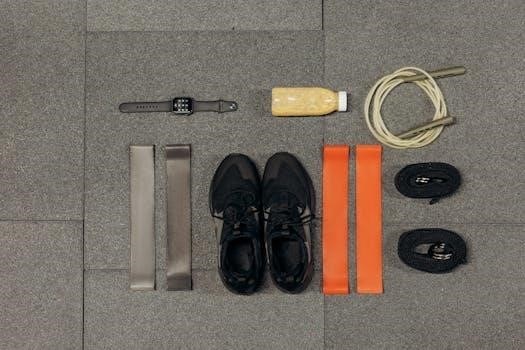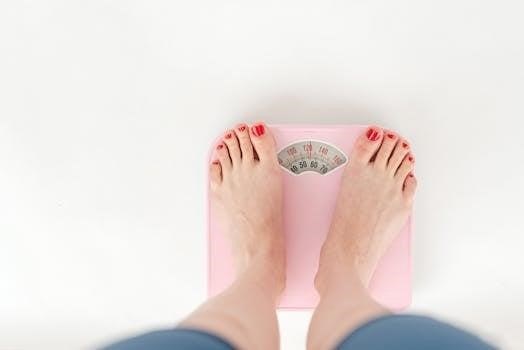weighted blanket weight guide kg

Weighted blankets are popular for relaxation, offering a calming effect through gentle pressure․ Selecting the right weight is crucial for comfort and safety․ This guide focuses on understanding how to choose the appropriate weight in kilograms, ensuring a beneficial experience․
What is a Weighted Blanket?
A weighted blanket is a blanket designed with added weight, typically from materials like glass beads or plastic pellets, to provide a deep pressure sensation․ This extra weight distinguishes them from regular blankets, offering a feeling similar to being hugged or swaddled․ They are often used to promote relaxation and improve sleep quality․ The weight is evenly distributed, aiming to create a calming effect for the user, contributing to a more restful experience․ They may be used as they are or as duvet inserts․
Calculating Ideal Weighted Blanket Weight in Kilograms
Determining the correct weighted blanket weight involves a simple calculation using your body weight in kilograms․ This section provides the standard method for calculating the appropriate weight for your needs․
Standard Calculation Method in Kg
To calculate the ideal weighted blanket weight in kilograms, first, determine your body weight in kilograms․ Then, divide this weight by ten․ Finally, add 0․68 kilograms to the result․ This formula provides a general guideline for a comfortable and effective weighted blanket, aiming for approximately 10% of your body weight, plus a small additional amount․ This method helps ensure the blanket provides gentle pressure without feeling too heavy․
Example Calculation for 80kg Person
Let’s calculate the ideal weighted blanket weight for someone weighing 80 kilograms․ First, divide 80 kg by 10, which equals 8 kg․ Next, add 0․68 kg to this result․ This gives us a total of 8․68 kg․ Therefore, for an 80 kg individual, a weighted blanket around 8․68 kg is generally recommended․ This example illustrates how to use the standard calculation method to find an appropriate blanket weight․

Weighted Blanket Weight Charts
Weight charts are valuable tools for selecting the correct weighted blanket․ These charts provide guidelines based on body weight, assisting users in choosing a blanket that offers optimal comfort and therapeutic benefits․
Weight Chart for Adults in Kg
When selecting a weighted blanket, adults can utilize a weight chart that is specifically designed using kilograms․ These charts typically present body weight ranges and their corresponding recommended blanket weights in kilograms․ For example, a person weighing between 45 and 55 kg might choose a blanket weighing 4․4 to 5;4 kg․ These charts serve as a starting point; individual preference may require slight adjustments․
Weight Chart for Adults in lbs and Kg
A comprehensive weight chart for adults often includes both pounds (lbs) and kilograms (kg) for ease of use․ This dual measurement system allows individuals to choose a blanket weight that aligns with their preferred unit․ For instance, a chart might indicate that a person weighing 100-120 lbs (45-55 kg) should consider a blanket weighing 10-12 lbs (4․4-5․4 kg), ensuring accessibility for all users․
General Weight Recommendations
General recommendations suggest that a weighted blanket should be around 10% of the user’s body weight․ However, individual preferences can vary, with some preferring a slightly heavier or lighter blanket․
The 10% Rule for Blanket Weight
The 10% rule is a common guideline for selecting a weighted blanket․ This rule suggests that the ideal weight of the blanket should be approximately 10 percent of the user’s body weight․ For example, if a person weighs 80 kilograms, the recommended blanket weight would be around 8 kilograms․ This starting point helps achieve a comfortable and effective experience, though personal preferences may lead to adjustments․
Variations in Weight Preferences
While the 10% rule serves as a general guideline, individual preferences for weighted blanket heaviness can vary․ Some people may prefer a slightly lighter blanket, while others find greater comfort with a heavier one․ These preferences can range from 5% to 12% of their body weight․ Experimenting within this range is essential to find the most suitable and comfortable weighted blanket for personal use․
Factors Affecting Blanket Weight Choice
Several factors influence the ideal weighted blanket weight․ Body weight is a primary consideration, but personal comfort and preferences also play a crucial role in determining the best option for an individual․
Body Weight
Body weight is a fundamental factor when selecting a weighted blanket․ A general rule suggests that the blanket should be approximately 10% of your body weight․ This is a starting point, and individual preferences may vary․ Heavier individuals generally require heavier blankets to achieve the desired pressure, while lighter individuals need lighter options to ensure comfort and safety․ Always consider your specific weight before choosing․
Personal Comfort and Preferences
Beyond body weight, personal comfort and preferences play a significant role in choosing the right weighted blanket․ Some people prefer a heavier blanket for a more secure, snug sensation, while others find lighter options more comfortable and less restrictive․ It’s essential to consider what feels best to you when under the blanket․ Experimentation might be needed to find your ideal weight and ensure a relaxing experience․

Weighted Blankets for Children
When selecting weighted blankets for children, safety is paramount․ Recommended weights are typically lower than for adults, often ranging from 3 to 12 pounds, depending on the child’s weight and needs․ Consulting a pediatrician is advised․
Recommended Weights for Children
For children, weighted blanket recommendations differ significantly from adults, usually ranging between 3 to 12 pounds, though this can vary․ It’s crucial to avoid blankets that are too heavy, as this can cause discomfort or restrict movement․ The general 10% rule should be approached with caution for children, often leaning towards lighter weights․ Always prioritize safety and comfort for the child’s well-being․
Consulting a Doctor for Children
Before introducing a weighted blanket to a child, consulting a family physician is highly recommended․ This ensures the blanket is suitable, especially considering any existing medical conditions or sensitivities․ A doctor can provide personalized advice on the appropriate weight, often suggesting lighter options to prioritize the child’s safety and comfort․ Medical guidance is crucial for children’s well-being while using weighted blankets․

Potential Risks and Considerations
Weighted blankets, while beneficial for some, pose risks to others, especially those with breathing issues․ A too-heavy blanket can restrict airflow․ Claustrophobia is another concern․ Medical consultation is advised before use․
Breathing Problems and Medical Conditions
Individuals with conditions affecting breathing, such as asthma or sleep apnea, should exercise caution when considering a weighted blanket․ The added weight can potentially restrict airflow, exacerbating existing breathing difficulties․ Consulting a doctor is crucial to ensure the safety of using a weighted blanket for those with respiratory or other medical conditions․ It is important to ensure the blanket is not too heavy and does not restrict breathing․
Claustrophobia and Discomfort
Even without pre-existing medical conditions, some individuals may experience discomfort or feelings of claustrophobia when using a weighted blanket․ The sensation of being enveloped or restricted can lead to unease․ It is important to choose a weight that feels comfortable and does not induce anxiety․ If there is any uncertainty about potential discomfort, consulting a physician before use is recommended, to avoid negative experiences․

Materials and Fillings in Weighted Blankets
Weighted blankets commonly utilize fillings like glass beads or plastic pellets to add weight․ These materials, along with batting, impact comfort and heat retention․ Material choice is crucial for an effective experience․
Types of Fillings⁚ Beads and Pellets
Weighted blankets often use small, dense materials to provide the necessary weight․ Glass microbeads are a common choice, known for their smooth texture and even distribution․ Plastic pellets, though less common now, also serve the purpose of adding weight․ The choice of filling affects the blanket’s overall feel, flexibility, and how it conforms to the body, making it a key consideration when selecting a weighted blanket․ These fillings are typically encased within the blanket’s layers․
Importance of Material and Fill
The material and fill of a weighted blanket significantly impact its comfort, breathability, and overall effectiveness․ The outer fabric should be soft, durable, and suitable for your skin, while the fill determines the blanket’s weight distribution and temperature regulation․ Materials like cotton or bamboo are breathable, while fills like glass beads offer a smooth, quiet experience․ The quality and type of both material and fill contribute significantly to the user’s satisfaction․
Benefits of Weighted Blankets
Weighted blankets are known for promoting relaxation and reducing stress by simulating a hug․ They may also improve sleep quality by creating a sense of security, potentially aiding those with anxiety․
Relaxation and Stress Reduction
Weighted blankets are believed to stimulate the production of happiness hormones like dopamine and serotonin, while reducing cortisol, the stress hormone․ This helps users enter a more relaxed state, conducive to sleep and overall well-being․ The gentle pressure mimics a hug, providing a sense of security and comfort that can ease anxiety and promote calmness, aiding in relaxation and stress reduction․
Potential Impact on Sleep Quality
The relaxing effect of weighted blankets can potentially improve sleep quality by creating a calming environment․ By reducing stress and anxiety, they may help individuals fall asleep more easily and experience fewer nighttime awakenings․ While some studies show promising results, the impact on sleep can vary between individuals․ It’s also important to consider personal comfort and weight preferences for optimal sleep enhancement․
Conclusion and Final Recommendations
Choosing the correct weighted blanket is a personal journey․ Consider your weight, comfort, and health․ When in doubt, consult a professional for tailored advice, ensuring a safe and beneficial experience․
Importance of Individualized Approach
Selecting a weighted blanket is not a one-size-fits-all process․ Personal preferences, body weight, and any health conditions play significant roles․ What feels comfortable and safe for one person may not be suitable for another․ It is essential to consider individual needs and comfort levels when determining the ideal weight․ Therefore, a personalized approach is crucial for achieving the best results and avoiding potential discomfort․
Seeking Professional Advice When Needed
Consulting a healthcare professional is advisable, particularly for individuals with pre-existing respiratory issues, sleep disorders, or other health concerns․ A doctor can provide personalized recommendations and assess whether a weighted blanket is safe and suitable․ This ensures that the chosen weight does not exacerbate any medical conditions․ It is also crucial for children, where professional guidance is key to ensure proper weight selection and safety․ Seeking expert advice provides informed decisions regarding weighted blanket use․